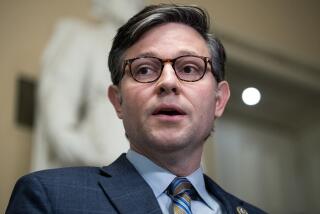Firms May Pay More for Retiree Health Benefits
- Share via
WASHINGTON — The Clinton Administration, forced to acknowledge that it may have underestimated the cost of providing health care for early retirees, has decided that corporations should pick up a larger part of those costs under the President’s health care reform plan, officials said Thursday.
The decision represented one of the largest policy changes to emerge this week as the White House studied newly revised cost estimates for its health care reform plan. Those estimates were prepared by the Treasury Department and the Office of Management and Budget.
Overall, however, most of the new cost estimates for health care reform remain close to original forecasts of the White House health care task force. And most important, officials said, the new estimates from the OMB and Treasury bolster the Administration’s most controversial contention--that it can pay for its ambitious health care reform plan without any broad-based tax increases.
In fact, the new figures provide an endorsement for the basic structure of Clinton’s financing system and are said to have made skeptics within the Administration, notably Treasury Secretary Lloyd Bentsen and chief White House economist Laura D’Andrea Tyson, more comfortable with the health care package. Administration officials said that the cost estimates are still open to further small revisions.
Senior Administration officials also said that the health care reform package will not generate as much deficit reduction as the White House had promised. The revised health care budget now calls for the plan to lower the deficit by about $70 billion between 1994 and 2000, down from a total of $91 billion forecast earlier.
The revised estimates support the Administration’s initial claims that it could rely largely on cost savings from Medicare and Medicaid--as well as on new taxes on cigarettes and on those firms that do not participate in the health plan--to pay for coverage for the uninsured and for other government subsidies. Officials said that the new figures for the amount of money that can be saved by slowing the growth in Medicare and Medicaid payments are almost unchanged from the original estimates. They call for $124 billion to be cut from Medicare spending and $114 billion from Medicaid between 1994 and 2000.
The exact size of a tax on cigarettes and other tobacco products remains unresolved, however, with the Administration still considering a range of between 75 cents and $1 a pack. Separately, the Administration apparently has decided to impose a 1% payroll tax on those firms that “opt out” of the new health care system and attempt to provide benefits on their own.
While the OMB and Treasury estimates may show that the Administration theoretically can finance its health care program largely from Medicare and Medicaid, many outside analysts have said that they believe it cannot be done without a tremendous reduction in the quality of care available to the nation’s elderly and poor.
Many health care experts have warned that such a massive reduction in payments would force health care rationing. The White House continues to stress, however, that it can obtain those savings through productivity improvements in the health care system and through the elimination of waste and duplication in the health care industry.
But eventually, the Administration will be forced to concede that the Medicare and Medicaid cuts “can’t be done,” warned Karen Davis, a health care economist at the Commonwealth Fund who worked on the Clinton health care task force. Then, she added, the White House will have to decide either to scale back benefits, stretch out the time in which it will phase in the program or raise taxes.
Even while the new estimates confirmed the Administration’s earlier position, senior White House officials stressed that those numbers do not make the Clinton financing mechanism any more politically palatable or realistic. “This shows that the numbers add up and you can’t question the validity of the numbers any more,” one official said. “That doesn’t mean you can’t debate whether they are politically possible.”
A draft report of the Administration’s health care proposal widely circulated in September called for the federal government to pay 80% of the health care costs for early retirees. In recent years, companies across the country have been forcing older workers to take early retirement to reduce labor costs and make use of younger workers who are paid less and receive fewer benefits. But those early retirees do not qualify for Medicare until they reach 65, and many companies still provide them with health coverage.
The Administration’s proposal to have the federal government pick up 80% of those costs, leaving either companies or individuals to pay the remaining 20%, would represent a huge windfall for old-line industrial firms with aging work forces.
But by assuming such costs, the government effectively would create a new entitlement for workers as young as 55, a full 10 years younger than the Medicare eligibility age. And Administration officials now fear that the benefit could accelerate the trend toward early retirement, leaving fewer active workers to contribute taxes to the Medicare and Social Security trust funds.
With that in mind, Administration officials are now proposing that corporations with early retirees pay an assessment of up to 50% of those costs back to the government, at least during the first three years the health care program is in operation.
The Administration has been considering such an assessment “all along,” a White House spokesman said Thursday.
More to Read
Get the L.A. Times Politics newsletter
Deeply reported insights into legislation, politics and policy from Sacramento, Washington and beyond. In your inbox twice per week.
You may occasionally receive promotional content from the Los Angeles Times.







